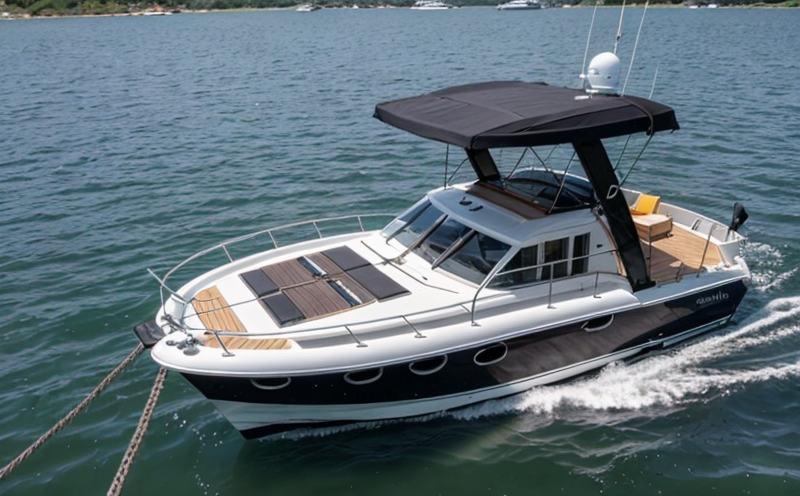DNVGL-ST-0378 Mooring System Verification Testing
The DNVGL-ST-0378 standard is a critical document for ensuring the structural integrity and operational reliability of mooring systems in marine environments. This testing protocol is essential for verifying that mooring components, such as anchors, chain, and shackles, meet design specifications and can withstand the harsh conditions they encounter during maritime operations.
The primary objective of DNVGL-ST-0378 verification testing is to validate that these systems comply with international safety standards. This process involves a series of mechanical tests designed to simulate real-world loading scenarios, which include static tension, dynamic impact forces, and cyclic loading conditions. The tests are conducted under controlled laboratory settings using sophisticated equipment capable of replicating the extreme environmental stresses experienced by mooring components.
The testing protocol requires that specimens undergo a rigorous pre-test inspection process before any mechanical testing can commence. This ensures that all components are in pristine condition, free from any manufacturing defects or damage. Once inspected, the components are subjected to static load tests to determine their ultimate breaking strength and elongation properties. Following this, dynamic impact force tests simulate collision impacts, which are common occurrences in maritime operations.
For cyclic loading tests, specimens are repeatedly loaded and unloaded under controlled conditions to assess how well they resist fatigue failures over extended periods of use. This is particularly important for components that experience continuous stress cycles during ship mooring activities. The results from these tests provide valuable insights into the expected lifespan and operational performance of the tested mooring systems.
The testing process also includes detailed non-destructive evaluation (NDE) techniques to assess the internal integrity of the specimens without causing any physical damage. These methods include ultrasonic testing, magnetic particle inspection, and radiographic examination. The findings from these NDE evaluations are crucial in identifying potential flaws or weaknesses within the mooring components before they enter service.
Once all tests have been completed and analyzed, comprehensive reports are generated detailing the test results, any discrepancies found during inspections, and recommendations for improvements if necessary. These reports serve as critical documents for quality managers, compliance officers, R&D engineers, and procurement personnel responsible for ensuring that marine equipment meets stringent safety standards.
The implementation of DNVGL-ST-0378 verification testing is not just about meeting regulatory requirements but also about enhancing the overall safety and reliability of mooring systems. By adhering to this standard, stakeholders can rest assured that their equipment will perform reliably under the most challenging conditions, thereby minimizing risks associated with maritime operations.
Why It Matters
The importance of DNVGL-ST-0378 verification testing cannot be overstated. In marine environments where mooring systems are subjected to extreme conditions, any failure can have severe consequences including damage to vessels and property, environmental pollution, and even loss of life. Ensuring that these critical components meet the highest safety standards is paramount.
The tests conducted under DNVGL-ST-0378 not only assess the physical strength and durability of mooring systems but also evaluate their resistance to fatigue and cyclic loading conditions. These factors are crucial in determining how well a system will perform over its intended operational life, which can span many years or even decades.
By adhering to this standard, manufacturers and operators demonstrate their commitment to safety and quality, thereby gaining the trust of stakeholders and customers alike. Compliance with DNVGL-ST-0378 also helps in maintaining a consistent level of performance across various mooring systems, ensuring that all components are equally robust and reliable.
The results of these tests provide valuable data for ongoing research and development efforts aimed at improving the design and manufacturing processes of marine equipment. This continuous improvement cycle ensures that new technologies and materials are integrated into existing systems, further enhancing their performance and safety.
Benefits
- Enhanced Safety: Ensures that mooring systems meet the highest safety standards, reducing risks associated with maritime operations.
- Improved Durability: Tests help identify potential weaknesses in components before they are put into service, extending their operational life.
- Fundamental Regulatory Compliance: Adherence to DNVGL-ST-0378 helps operators comply with international safety regulations and standards.
- Precision Evaluation: Non-destructive evaluation techniques provide accurate assessments of internal integrity without causing physical damage.
- Data for Improvement: Comprehensive reports offer valuable data points that can be used to enhance design and manufacturing processes.
Industry Applications
The DNVGL-ST-0378 verification testing is widely applicable across various marine sectors, including commercial shipping, offshore oil and gas, and naval defense. In the commercial shipping industry, ensuring that mooring systems meet stringent safety standards is crucial to prevent accidents and operational disruptions. For offshore oil and gas operations, reliable mooring systems are essential for securing platforms and rigs in harsh sea conditions. The naval defense sector also relies heavily on robust mooring equipment to secure vessels and protect critical assets.
- Commercial Shipping: Ensuring the safety of ships through rigorous testing of mooring components.
- Offshore Oil & Gas: Securing platforms and rigs in challenging maritime environments.
- Naval Defense: Protecting critical assets by securing vessels with reliable mooring systems.





